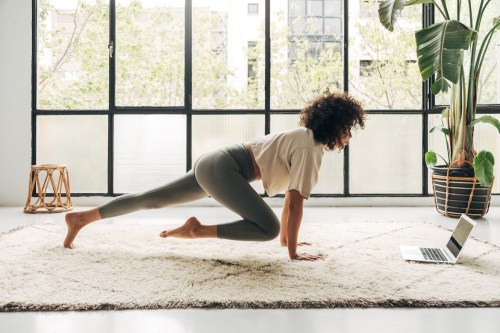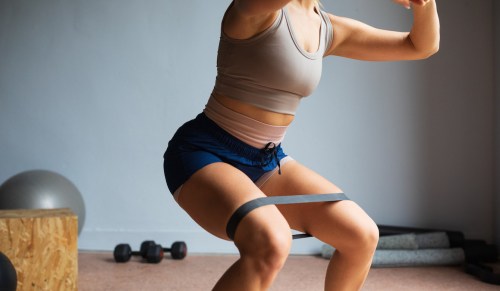When you go to the gym, you may hit the elliptical for 10 to 20 minutes, perform a strength routine near the barbell rack, do a few reps of Russian twists and crunches on a mat, and call it a day.
Experts in This Article
certified personal trainer and owner of Fit Healthy Macros
What many of us tend to de-prioritize is deep core muscle work. And no, we’re not talking about movements that target the superficial abs muscles, aka the six-pack bunch. Instead, we’re asking you to think deeper (literally) and reframe your mindset from vanity to longevity. By targeting those deep core muscles, you may alleviate back pain, support pelvic floor function1, and improve posture2.
What is your deep core?
As its name suggests, your deep core muscles are beneath the rectus abdominis, or that top layer of abs muscles. “The deep core refers to the group of muscles located closest to your spine and pelvis that provide stability, support, and control,” says Tami Smith, CPT, NASM-certified personal trainer, macro coach, and founder of the Fit Healthy Macros app.
Deep core muscles include:
- Transverse abdominis: The deepest abs muscle that spans from your lower ribs to your pelvis, the transverse abdominis holds your internal organs in place.
- Pelvic floor muscles: Located at the base of your core, stretching from your pubic bone to your tailbone, your pelvic floor muscles hold your bladder, large intestine, and internal reproductive organs in place and play a role in tasks like peeing, pooping, and sex.
- Diaphragm: Located below your lungs and heart, the diaphragm separates your chest from your stomach.
- Multifidus: The multifidus is a set of long, narrow muscles that run along your spinal column that stabilize your lumbar spine.
Why is it important to work your deep core muscles?
You can think of your deep core muscles as stabilizers, Smith says. They can support your spine’s range of motion and protect you from injury, according to the Cleveland Clinic.
“If you work your deep core muscles consistently, you can expect to improve your posture, lower your risk of lower back pain, and improve your everyday movements. This includes things like bending over and picking up the laundry or playing recreational sports,” Smith says. She adds that strengthening deep core muscles is especially important for athletes who make rotational movements, including those who play golf, volleyball, and softball.
Deep core muscle exercises improve your functional strength, which can help the other larger muscle groups in your body perform more efficiently, Smith explains.
“If you work your deep core muscles consistently, you can expect to improve your posture, lower your risk of lower back pain, and improve your everyday movements.” —Tami Smith, CPT
The 5 best deep core exercises
Perform this handful of movements daily to activate those deep core muscles.
1. Dead bug
This movement is powerful for those with low back pain. “Dead bugs target the transverse abdominis,” Smith says. “This move requires you to stabilize your spine while your limbs move separately.”
- 1.Lie on your back with your arms extended toward the ceiling and knees bent at 90 degrees and also pointing to the ceiling.
- 2.Engage your core to press your lower back into the floor.
- 3.Slowly extend your left leg and lower it toward the floor while simultaneously lowering your right arm overhead.
- 4.Return to the starting position and repeat with the opposite arm and leg.
- 5.Continue alternating sides, keeping your movements slow and controlled.
- 6.Perform 10 to 12 reps on each side.
2. Butterfly sit-up
It might look like your shoulders and arms are doing the heavy lifting in this exercise, but don’t be mistaken—your deep core muscles drive the movement. “This move activates the rectus abdominis and requires deep core engagement to stabilize the pelvis and prevent your back from overarching,” Smith says.
- 1.Sit on the floor with the soles of your feet pressed together and drop your knees to each side. Your legs should make a diamond shape.
- 2.Lie down on your back with your arms extended overhead.
- 3.Engage your core and exhale as you sit up, reaching for your feet.
- 4.Lower back down in a controlled manner.
- 5.Perform 12 to 15 reps.
3. Weighted thread the needle
This rotational movement engages your obliques, or the muscles on the sides of your core. At the same time, the transverse abdominis stabilizes your spine during this motion, Smith says. “You sustain that activation of the deep core by side planking.”
- 1.Begin in a side plank with your right forearm on the floor, holding a dumbbell in your left hand (palm facing forward).
- 2.Extend your left arm straight up, holding the dumbbell.
- 3.Rotate your torso and thread the dumbbell under your body.
- 4.Return to the starting position.
- 5.Perform 8 to 10 reps per side.
4. Superhero hold
This may just be the spiciest movement in the lineup as it requires you to stay still and in control. “This move activates the multifidus and the spine, while your glutes and core work together to maintain the hold,” Smith says.
- 1.Lie face down with your arms extended in front of you. Extend your legs straight.
- 2.Engage your core and glutes as you lift your chest, arms, and legs off the floor.
- 3.Hold for a few seconds, then lower.
- 4.Repeat for 3 sets.
5. Plank with shoulder tap
Planks engage numerous muscles in your core, including the transverse abdominis and obliques. “[The plank] stabilizes the body to resist rotation, while the shoulder tap challenges your ability to maintain balance and core control,” Smith says.
- 1.Start in a high plank position with your hands planted firmly on the ground, directly under your shoulders and feet hip-width apart.
- 2.Engage your core and glutes to maintain a straight line from your head to your heels.
- 3.Lift your right hand off the floor and tap your left shoulder, then immediately return your right hand to the floor.
- 4.Lift your left hand off the floor and tap your right shoulder, then immediately return your left hand to the floor.
- 5.Alternate sides, keeping your hips and torso stable.
- 6.Perform 10 to 12 taps per side.
Hsu SL, Oda H, Shirahata S, Watanabe M, Sasaki M. Effects of core strength training on core stability. J Phys Ther Sci. 2018 Aug;30(8):1014-1018. doi: 10.1589/jpts.30.1014. Epub 2018 Jul 24. PMID: 30154592; PMCID: PMC6110226.
↩︎Rathore M, Trivedi S, Abraham J, Sinha MB. Anatomical Correlation of Core Muscle Activation in Different Yogic Postures. Int J Yoga. 2017 May-Aug;10(2):59-66. doi: 10.4103/0973-6131.205515. PMID: 28546675; PMCID: PMC5433114.
↩︎
Sign Up for Our Daily Newsletter
Get all the latest in wellness, trends, food, fitness, beauty, and more delivered right to your inbox.
Got it, you've been added to our email list.











